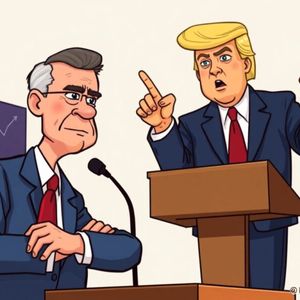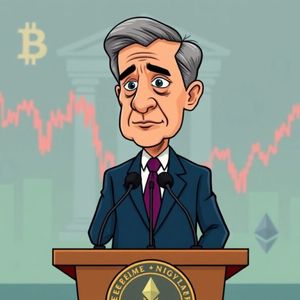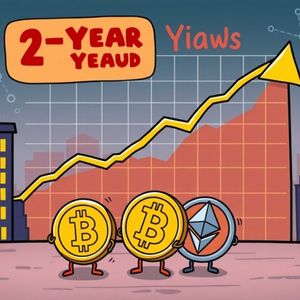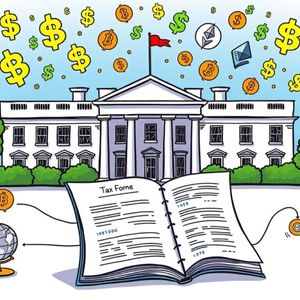BitcoinWorld Crucial Interest Rates: Trump’s Unexpected Stance on Fed Policy In the dynamic world of finance, where every whisper from a key figure can send ripples across markets, understanding the interplay between traditional economic policy and the burgeoning cryptocurrency landscape is paramount. The crypto market, known for its volatility, is particularly sensitive to macroeconomic shifts, and few factors hold as much sway as decisions surrounding interest rates . Recently, a notable statement from former U.S. President Donald Trump has once again brought this crucial topic into the spotlight, sparking discussions on what it could mean for the financial future, including digital assets. What Did Trump Say About Interest Rates? According to a report by Walter Bloomberg on X, former U.S. President Donald Trump recently expressed his opinion regarding the Federal Reserve’s immediate plans for interest rates . Trump stated that he believes Federal Reserve Chair Jerome Powell is unlikely to lower interest rates today. This commentary, coming from a former head of state with a history of vocal opinions on economic policy, naturally garners significant attention from investors, analysts, and the general public alike. Trump’s statement, while an observation rather than a direct policy directive, highlights the ongoing speculation surrounding the Federal Reserve’s next moves. The market is constantly trying to anticipate whether the Fed will maintain, raise, or lower its benchmark interest rate, as these decisions have profound implications for borrowing costs, consumer spending, and investment strategies across all sectors, including the highly sensitive cryptocurrency market. Why Do Interest Rates Matter So Much for Crypto? The relationship between traditional interest rates and the performance of cryptocurrencies might not be immediately obvious to everyone, but it is deeply intertwined. Here’s why Fed decisions on interest rates are a critical factor for the crypto space: Risk Appetite: Lower interest rates generally make it cheaper to borrow money, encouraging investment and risk-taking. In such an environment, investors are more inclined to put capital into higher-risk, higher-reward assets like cryptocurrencies. Conversely, higher interest rates make safer investments (like bonds or savings accounts) more attractive, drawing capital away from speculative assets. Liquidity: When interest rates are low, there’s more money flowing through the economy. This increased liquidity can find its way into various asset classes, including crypto, boosting demand and prices. Tightening monetary policy by raising rates can reduce this liquidity, making it harder for assets to climb. Dollar Strength: Higher interest rates typically strengthen the U.S. dollar, as foreign investors are drawn to higher returns on dollar-denominated assets. A stronger dollar can make cryptocurrencies, which are often priced against the dollar, appear more expensive for international buyers, potentially dampening demand. Cost of Capital: For crypto projects and companies, higher interest rates mean higher borrowing costs, which can impact their growth, development, and overall profitability. This can, in turn, affect investor confidence in the broader crypto ecosystem. Understanding these dynamics is crucial for anyone looking to navigate the crypto market effectively, as external macroeconomic factors often dictate broader market trends, even for seemingly independent digital assets. The Federal Reserve’s Balancing Act: Inflation vs. Growth Jerome Powell and the Federal Reserve operate under a dual mandate: to achieve maximum employment and maintain price stability (i.e., control inflation). The decision to raise, lower, or maintain interest rates is a complex one, influenced by a myriad of economic indicators: Inflation Data: The Consumer Price Index (CPI) and Personal Consumption Expenditures (PCE) are key metrics. If inflation is high and persistent, the Fed is more likely to keep rates higher or even raise them to cool down the economy. Employment Figures: Unemployment rates, job growth, and wage increases provide insights into the health of the labor market. A strong job market might give the Fed more room to raise rates without fear of stifling economic growth too much. GDP Growth: Gross Domestic Product indicates the overall economic output. A slowing economy might prompt the Fed to consider rate cuts to stimulate activity. Global Economic Conditions: International events, geopolitical tensions, and global economic slowdowns can also influence the Fed’s decisions, as the U.S. economy is not isolated. Given the current economic climate, marked by lingering inflation concerns and a relatively robust job market, the Fed faces a delicate balancing act. Any shift in their stance on interest rates is meticulously scrutinized by markets worldwide, as it signals the central bank’s confidence in the economy’s trajectory and its commitment to its mandates. How Do Markets React to Interest Rate Speculation? Market reactions to statements like Trump’s, or indeed any significant commentary on interest rates , are typically swift and often volatile. This is particularly true for the crypto market, which is known for its rapid price swings. Here’s how speculation can play out: Scenario Potential Market Reaction (General) Potential Crypto Market Reaction Expectation of Rate Cut Equities up, bonds down, dollar weakens. Typically positive, as risk assets become more attractive. Increased liquidity. Expectation of Rate Hike Equities down, bonds up, dollar strengthens. Typically negative, as risk assets become less attractive. Reduced liquidity. Rates Held Steady (Unexpectedly) Mixed, depending on prior expectations. Volatile, as market recalibrates. Could be positive if prior expectation was hike, or negative if cut was hoped for. Uncertainty/Mixed Signals Increased volatility, cautious trading. High volatility, indecision, potential for sharp moves in either direction. Trump’s statement, suggesting no immediate rate cut, could reinforce the market’s expectation of the Fed holding steady for now. This might lead to a muted reaction if it aligns with existing consensus, or a slight negative bias for risk assets if some investors were still holding out hope for an imminent cut. However, the true impact often depends on the official Fed announcement and accompanying statements, which provide more definitive guidance. Navigating the Economic Tides: Actionable Insights for Crypto Investors For crypto investors, staying informed about macroeconomic trends, especially those related to interest rates , is not just advisable but essential. Here are some actionable insights to help navigate these complex waters: Diversify Your Portfolio: While crypto can offer significant returns, its volatility means a well-diversified portfolio is key. Consider balancing high-risk crypto assets with more stable investments. Stay Informed, Not Reactive: Follow reputable financial news sources, listen to official Fed announcements, and understand the underlying economic data. Avoid making impulsive decisions based on single statements or short-term market noise. Long-Term Perspective: The crypto market has a history of resilience. While short-term fluctuations due to interest rate speculation are common, a long-term investment strategy often helps weather these storms. Understand Correlation: Recognize that while crypto can move independently, it increasingly correlates with traditional financial markets, especially during periods of significant economic shifts related to interest rates. Consider Stablecoins: In times of high volatility or uncertainty regarding interest rate movements, stablecoins can offer a temporary refuge for capital within the crypto ecosystem, allowing investors to preserve value without exiting crypto entirely. Ultimately, successful investing in the current climate requires a blend of vigilance, strategic planning, and a deep understanding of how global economic forces, particularly central bank policies on interest rates , can influence the digital asset space. Conclusion Donald Trump’s recent comments on Federal Reserve Chair Jerome Powell’s likelihood of not cutting interest rates today underscore the constant scrutiny faced by central banks and the profound impact their decisions have on financial markets worldwide. For the cryptocurrency community, these macro-level pronouncements are not just distant economic news; they are critical indicators that can influence market sentiment, liquidity, and ultimately, asset valuations. As the global economy continues to navigate inflation, employment challenges, and geopolitical shifts, the Federal Reserve’s stance on interest rates will remain a pivotal factor. Investors who pay close attention to these signals, understand their implications for risk appetite, and adopt a well-informed, strategic approach will be better positioned to navigate the evolving landscape of both traditional and digital finance. Frequently Asked Questions (FAQs) Q1: What is the Federal Reserve’s primary role regarding interest rates? A1: The Federal Reserve’s primary role, under its dual mandate, is to achieve maximum employment and maintain price stability (control inflation). It uses monetary policy tools, primarily adjusting the federal funds rate (a key interest rate), to influence borrowing costs and economic activity to meet these goals. Q2: How do high interest rates generally affect the crypto market? A2: High interest rates typically make traditional, less risky investments (like bonds) more attractive. This can lead investors to pull capital from speculative assets like cryptocurrencies, potentially causing prices to fall. Higher rates also increase borrowing costs for crypto projects, impacting their growth. Q3: Why did Donald Trump comment on interest rates? A3: Donald Trump has historically been vocal about Federal Reserve policy and interest rates, particularly during his presidency. His recent comment is an observation based on his economic perspective and ongoing market speculation regarding the Fed’s next move. Q4: Is the crypto market always negatively impacted by high interest rates? A4: While there’s a general correlation where higher interest rates can negatively impact crypto, the market is complex. Other factors like technological advancements, adoption rates, regulatory developments, and unique crypto-specific events can also influence prices, sometimes counteracting the effects of interest rate changes. However, the overall trend often aligns with macro-economic conditions. Q5: What should crypto investors do when there’s uncertainty about interest rate decisions? A5: During periods of interest rate uncertainty, crypto investors should prioritize staying informed, diversifying their portfolios, and considering a long-term investment strategy. Avoiding impulsive decisions based on short-term news and understanding the broader economic context are crucial. If you found this article insightful, consider sharing it with your network! Your support helps us continue providing valuable analysis on the intersection of traditional finance and the exciting world of cryptocurrencies. To learn more about the latest crypto market trends, explore our article on key developments shaping Bitcoin price action. This post Crucial Interest Rates: Trump’s Unexpected Stance on Fed Policy first appeared on BitcoinWorld and is written by Editorial Team















